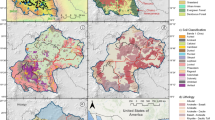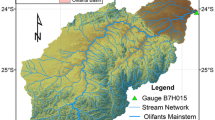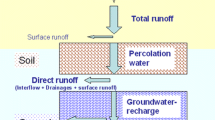Abstract
A semi-distributed groundwater recharge model that can be used to estimate the daily water-table fluctuations on a daily basis is presented. The model is based on the water-balance concept and links atmospheric and hydrogeologic parameters to different water uses. It is calibrated and validated using 10 years of data; data for the first 6 years - from 2000 to 2005 - is used for model calibration, whereas data for the remaining 4 years - from 2006 to 2009 - is used for validation. Goodness-of-fit measures such as the Nash-Sutcliffe Efficiency (ENS) and the coefficient of determination (R2) were evaluated to assess the performance of the model. This model can serve as a powerful tool to help engineers and decision makers in controlling excessive groundwater usage and preventing drastic depletion of groundwater resources. This is of considerable significance in basins of this type which are densely populated and the draft is reasonably high. This model demonstrated that with a reliable and detailed input database, the accuracy of predictions can be improved considerably.









Similar content being viewed by others
References
Alemaw BF, Chaoka TR (2003) A continental scale water balance model: a G IS approach for southern Africa. Phys Chem Earth 28:957–966
Allen RG, Pereira LS, Raes D, Smith M (1998) Crop evapotranspiration: guidelines for computing crop requirements. FAO Irrigation and Drainage Paper No. 56. FAO, Rome
Anuraga TS, Ruiz L, Mohan Kumar MS, Sekhar M, Leijnse A (2006) Estimating groundwater recharge using land use and soil data: A case study in South India. Agric Water Manag 84:65–76
Arnold JG, Allen PM (1999) Automated methods for estimating baseflow and groundwater recharge from streamflow records. J Am Water Res Assoc 35:411–424
Avery WJ, Donovan J, Ketchum N (1999) Recharge estimation by stage-discharge interpretation from cross-correlated well measurements. Groundwater 37:332–337
Banerjee P, Singh VS (2012) Statistical approach for comprehensive planning of watershed development through artificial recharge. Water Resour Manage 26:2817–2831. doi:10.1007/s11269-012-0048-7
Barthel R, Reichenau TG, Krimly TD, Schneider K, Mauser W (2012) Integrated modeling of global change impacts on agriculture and groundwater resources. Water Resour Manage 26:1929–1951. doi:10.1007/s11269-012-0001-9
Bouwer H (1978) Groundwater hydrology. McGraw-Hill, New York, pp 299–306
CGWB (2009) Annual Report. Central Groundwater Board, Ministry of Water Resources, Government of India
Doorenbos J, Pruitt WO (1977) Guidelines for predicting crop water requirement. FAO Irrigation and Drainage Paper No. 24. FAO, Rome
Doorenbos J, Pruitt WO (1997) Crop water requirements. Irrigation and Drainage, Paper 24, Food and Agricultural Organization of the United Nations, Rome (revised)
Favreau G, Leduc C, Marlin C, Dray M, Taupin JD, Massault M, Salle CLGL, Babic M (2002) Estimate of recharge of a rising water table in semiarid Niger from 3H and 14C modeling. Ground Water 40:144–151
Finch JW (2001) Estimating change in direct groundwater recharge using a spatially distributed soil water balance model. Q J Eng Geol Hydrogeol 34:71–83
Giammarco PD, Giardino PT, Rametta F, Todini E (1992) Integrated catchment modeling and meso-scale hydrology. In: Rosso R, Peano A, Becchi I, Bemporad GA (eds) Advances in distributed hydrology. Water Resources Publications, Highlands Ranch, pp 247–292
Grindley J (1967) The estimation of soil moisture deficits. Meteorol Mag 96:97–108
Haan PK, Skaggs RW (2003) Effects of parameter uncertainty on DRAINMOD predictions: hydrology and yield. Trans Am Soc Agric Eng 46(4):1,061–1,067
He B, Takase K (2006a) Impact of land use change on the groundwater recharge in a coastal plain. Proc JSHWR 160:286–287
He B, Takase K (2006b) Application of the artificial neural network method to estimate the missing hydrological data. JSHWR 19(4):249–257
He B, Takase K, Wang Y (2008) A semi-distributed groundwater recharge model for estimating water-table and water-balance variables. Hydrogeol J 16:1215–1228
Howard KWF, Lloyd JW (1979) The sensitivity of parameters in the Penman evaporation equations and direct recharge balance. J Hydrol 41:329–344
Huang M, Jacgues G, Wang Z, Monique G (2006) A modification to the soil conservation service curve number method for steep slopes in the Loess Plateau of China. Hydrol Processes 20(3):579–589
Jones JAA (1999) Climate change and sustainable water resources: placing the threat of global warming in perspective. Hydrol Sci J 44(4):541–557
Katerji N, Rana G (2006) Modelling evapotranspiration of six irrigated crops under Mediterranean climate conditions. Agric For Meteorol 138:142–155
Ketchum J, Donovan J, Avery W (2000) Recharge characteristics of a phreatic aquifer as determined by storage accumulation. Hydrogeol J 8:579–593
Khazaei K, Spink AEF, James W (2003) A catchment water balance model for estimating groundwater recharge in arid and semiarid regions of south-east Iran. Hydrogeol J 11:333–342
Krishnakumar KN, Prasada Rao GSLHV, Gopakumar CS (2009) Rainfall trends in twentieth century over Kerala, India. Atmos Environ 43:1940–1944
Manghi F, Mortazavi B, Crother C, Hamdi MR (2009) Estimating regional groundwater recharge using a hydrological budget method. Water Resour Manage 23:2475–2489. doi:10.1007/s11269-008-9391-0
Mileham L, Taylor RG, Todd M, Tindimugaya C, Thompson J (2009) The impact of climate change on groundwater recharge and run-off in a humid, equatorial catchment: sensitivity of projections to rainfall intensity. Hydrol Sci J 54(4):727–738
Monteith JL (1981) Evaporation and surface temperature. Q J R Meteorol Soc 107:1–27
Otto R (2001) Estimating Groundwater Recharge Rates in the Southeast Holstein Region, Northern Germany. Hydrogeol J 9:498–511
Priestly CHB, Taylor RJ (1972) On the assessment of surface heat fluxes and evaporation using large scale parameters. Mon Weather Rev 100:81–92
Ramanarayanan TS, Williams JR, Dugas WA, Hauck LM, McFarland AMS (1997) Using APEX to identify alternative practices for animal waste management. ASAE Paper No. 972209. ASAE, St. Joseph
Refsgaard JC, Storm B (1996) Construction, calibration and validation of hydrological models. In: Abbott MB, Refsgaard JC (eds) Distributed hydrological modelling. Kluwer, Dordrecht, pp 41–54
Santhi C, Arnold JG, Williams JR, Dugas WA, Srinivasan R, Hauck LM (2001) Validation of the SWAT model on a large river basin with point and nonpoint sources. J Am Water Res Assoc 37(5):1169–1188
Scanlon BR, Cook PG (2002) Theme issue on groundwater recharge. Hydrogeol J 10:3–4
Scanlon BR, Reedy RC, Stonestrom DA, Prudic DE, Dennehy KF (2005) Impact of land use and land cover change on groundwater recharge and quality in the southwestern USA. Glob Chang Biol 11:1577–1593
Sugawara M (1995) Tank model. In: Singh VP (ed) Computer models of watershed hydrology. Water Resources Publ, Highlands Ranch
Sugawara M, Funiyuki M (1956) A method of revision of the river discharge by means of a rainfall model. Collection of research papers about forecasting hydrologic variables. The Geosphere Research Institute of Saitama University, Saitama, pp 14–18
Takase K (2000) Hydrologic cycle and water resource in a basin on the coast of Seto Inland Sea. JSIDRE 68:173–179
Thornthwaite CW (1948) An approach toward a rational classification of climate. Geol Rev 38(1):55–94
Thornthwaite CW, Mather JR (1957) Instructions and tables for computing potential evapotranspiration and the water balance. Public Climatol 10(3)
Xu X, Huang G, Qu Z, Pereira LS (2011) Using MODFLOW and GIS to assess changes in groundwater dynamics in response to water saving measures in irrigation districts of the Upper Yellow River Basin. Water Resour Manage 25:2035–2059. doi:10.1007/s11269-011-9793-2
Yeh HF, Chen JF, Lee CH (2004) Application of a water budget model to evaluate rainfall recharge and slope stability. J Chin Inst Environ Eng 14:1–10
Yeh H-F, Lee C-H, Chen J-F, Chen W-P (2007) Estimation of groundwater recharge using water balance model. Water Resour 34(2):153–162
Author information
Authors and Affiliations
Corresponding author
Rights and permissions
About this article
Cite this article
Raneesh, K.Y., Thampi, S.G. A Simple Semi-distributed Hydrologic Model to Estimate Groundwater Recharge in a Humid Tropical Basin. Water Resour Manage 27, 1517–1532 (2013). https://doi.org/10.1007/s11269-012-0252-5
Received:
Accepted:
Published:
Issue Date:
DOI: https://doi.org/10.1007/s11269-012-0252-5




